Odisha-The Beauty On Its Own
May 28, 2019 • 78 views
Odisha
Cradled between the sun-kissed beaches of the Bay of Bengal and the dense forests of the Eastern Ghats, Odisha, the land of temples, is an experience that is at once sublime and aesthetically invigorating.
Nature
1.Chilika Lake
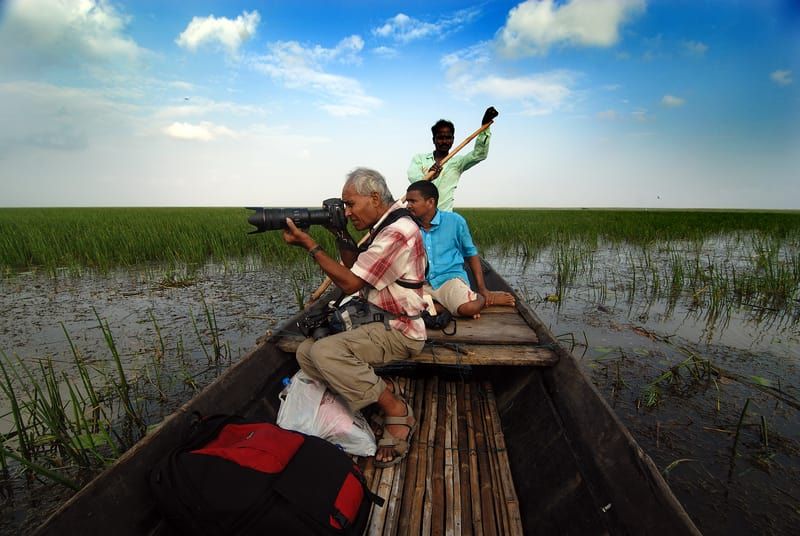
Chilika Lake
Asia’s largest brackish water lagoon with estuarine character, Chilika is a wintering ground for migratory birds on the Indian subcontinent. It offers tourists a spectacular display of avian acrobatics by over 160 species in myriad hues in the peak season between November and February.
The Chilika Wildlife Sanctuary, spread over 1,100 sq km, is one of the most important wetlands in the world, being home to a number of threatened species of plants and animals, and an extraordinary variety of resident and migratory birds. It’s Nalabana Island, which covers 16 sq km of the lagoon area, teams with nesting birds that include flamingos, ospreys, golden plovers, sandpipers, white-bellied sea eagles, Brahminy kites, spot-billed pelicans, spoonbills, avocets, and ibises from Central Asia, Iran and Siberia. The sanctuary also envelopes in its verdant folds blackbuck, chital, golden jackals, hyenas and several other felines and canine species. While Chilika is an ecosystem with large fishery resources and boasts a wealth of marine life, including 225 or more species of fishes, crabs, prawns and limbless lizards, it is particularly famed for the Irrawaddy dolphins. Purushottam Das, a poet-saint of Odisha and ardent devotee of Lord Jagannath, wrote a poem on Lord Krishna 400 years ago. The ode describes Krishna dancing with Maniki, a milkmaid who was vending curd on the shore of Chilika. Even today, one may see the Manikagauda village in the lagoon!
2.Bhitarkanika
Bhitarkanika is derived from two Oriya words—‘Bhitar’ meaning interior and ‘Kanika’ meaning that which is extraordinarily beautiful. Three rivers, Brahmin, Baitarani, and Patasala, flow out to sea at Bhitarkanika, forming a tidal maze of muddy creeks and mangroves. Bhitarkanika, a hot-spot of biodiversity, covers 672 sq km of mangrove forests and wetland. It is home to the largest population of giant salt water crocodiles in India, earning the status of a crocodile sanctuary. Hundreds of massive estuarine crocodiles bask on mudflats. The sanctuary is also one of the largest rookeries for Olive Ridley sea turtles and the second largest viable mangrove ecosystem in the country with over 70 varieties of mangroves that serve as a nesting ground for its large migratory avian population.
It is deemed one of Asia’s most impressive wildlife sanctuaries with a crisscrossing network of brooks, rivers, estuaries, backwaters, and mudflats, with the Bay of Bengal on the east. An ideal trekking, camping and picnic site, Bhitarkanika is accessed only by boat. Birdwatchers and photography buffs will have a field day, capturing eight species of brilliantly colored kingfishers, in addition to other bird species.
3.Gahirmatha Marine Sanctuary
The first and only marine sanctuary of Odisha, it stretches from the Dhamra river mouth in the north to the Mahanadi river mouth in the south and forms part of the Bhitarkanika National Park. It comprises mudflats, mangroves, and sea beaches, covering 1,408 sq km. Since time immemorial, the virgin sandy beaches of the sanctuary have served as a hatchery for the Olive Ridley sea turtles that migrate en masse from the Indian Ocean during the winter. Tens of thousands of turtles congregate on the sands of Gahirmathauntil the end of March. In view of its ecological importance and to protect the sea turtles, the government of Odisha declared Gahirmatha a turtle sanctuary in 1979.
4.Simlipal National Park
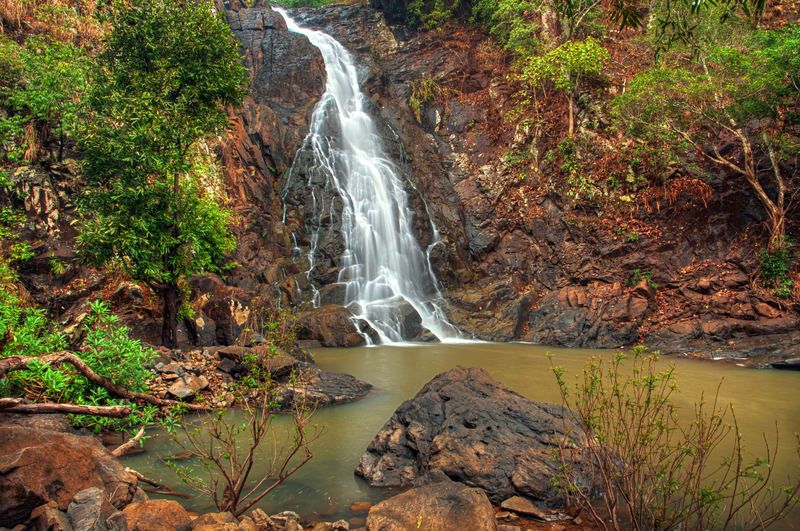
Simlipal Waterfall
The Simlipal National Park, once a hunting preserve of the Mayurbhanj maharajas, is a wildlife haven at an altitude of 559.31 m, and one of India’s biggest tiger sanctuaries, extending over 2,750 sq km within a larger 4,374-sq-km biosphere reserve. Since 2009, it has been a part of the UNESCO World Network of Biosphere Reserves.
Simlipal, which is set on a wide expanse of sal forests, has innumerable medicinal and aromatic plants that serve as a source of income for its tribal population. It derives its name from the abundance of simul or red silk cotton trees that bloom here. It is an expansive blend of the Western Ghats, Eastern Ghat, and sub-Himalayan floral species and boasts an astonishing 1,076 varieties of flowers and 96 species of orchids.
With variegated topography studded with perennial streams, rivers, waterfalls, gorges, valleys, and peaks, Simlipal is home to a range of wild animals, fishes, and birds. It is home to three of India’s biggest animal species—the tiger, Asian elephant, and gaur. Simlipal is famed for Project Tiger, initiated in May 1973 and the Mugger Crocodile Scheme that began in 1979.
With its undulating hilly terrain, Simlipal offers all grades of trekking challenges to adventure-seekers.
5. Ushakothi Wildlife Sanctuary
The Badrama Wildlife Sanctuary, more popularly known by the town where it is located, Ushakothi, is between the Wardha and Penganga rivers. According to legend, sage Vashisht created the Wardha river which also goes by the name of River Vashisht. Ushakothi, declared a sanctuary in 1962, is filled with deciduous forests of casuarina, Arjun, sal, acacia and neem trees.
Enjoy a jeep safari in the depths of its jungles and observe up close the panthers for which the sanctuary is famed, besides tigers, hyenas, wild boar and a host of other animals. If you are lucky, you could spot sloth bears who make their way to the water-bodies at night. Capture on your digital devices from atop one of the two 30-foot watch towers the beauty of the wilderness, the creatures of the jungle, and the racquet-tailed drongos and flying squirrels which are the prime attractions.
6.Satkosia Gorge And Wildlife Sanctuary
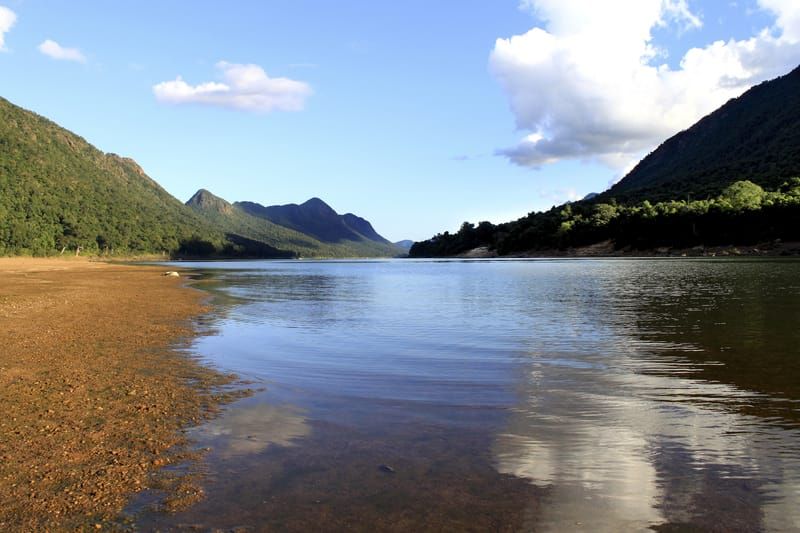
Satkosia Gorge
Satkosia, at the confluence of the Deccan peninsula and the Eastern Ghats, has an exclusive geomorphology as the Mahanadi plunges through the Eastern Ghats to form a 22-km gorge. The Satkosia Gorge Wildlife Sanctuary spanned 1,330 sq km and was established in 1976. It was declared a tiger reserve in 2007, comprising the Satkosia Gorge and Baisipalli Sanctuaries, spread over Angul, Budh, Cuttack and Nayagarh districts of Odisha. The Mahanadi elephant reserve and the Gharial Breeding Project are significantaspects of the sanctuary. Covered with dry deciduous forests and moist peninsular sal forests, the sanctuary is a natural habitat for a host of wild creatures, including muggers, fresh water turtles and a variety of snakes.
7.Gopalpur-on-Sea
Gopalpur-on-Sea is a port city with pristine beaches fringed by coconut groves and casuarinas. The small town is picturesque with rolling hills descending dramatically upon the Bay of Bengal. Gopalpur offers sailing, surfing, scuba diving, rowing, and swimming. In addition, you can go out to sea in paddle boats and on water scooters.
Catch a glimpse of the glorious history of the once-humming seaport, palpable from the crumbling walls and pillars of the jetty. The town, which was left to slide into history by the British, was rediscovered by holidaymakers from Bengal in the early 1980s.The annual Gopalpur Beach Festival in December sees the town thrum with activity.
8. Puri Beach
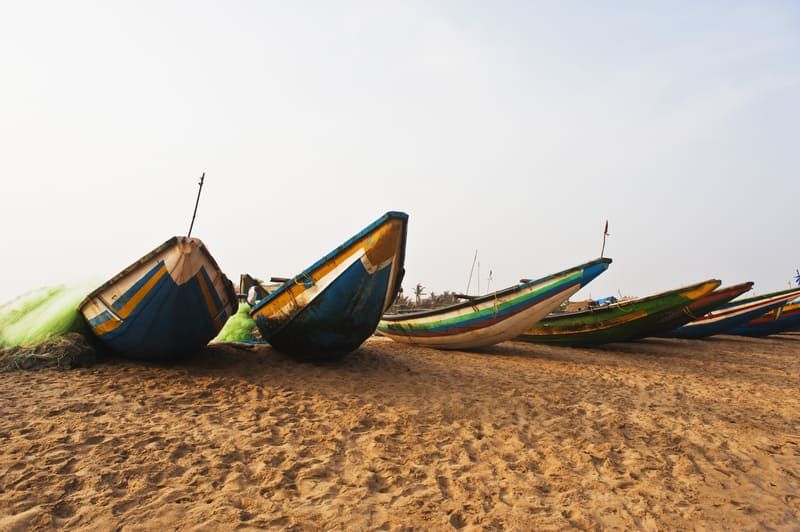
Puri Beach
This beach has become synonymous with devotees who bathe here before offering obeisance to its deity, Jagannath, and his siblings at the temple. The Beach Festival that takes place in November draws beach-lovers from India and abroad. The sand sculptures, especially by the world acclaimed artist, Sudarshan Patnaik, add their own magic. The beach at Puri is unique in that it offers stunning views of both sunrise and sunset. With its warm sea-lapped beach that abounds in water sports, this city offers a sublime as well as invigorating experience to tourists and vacationers, especially because of thehotels in Purithat suit the needs of all kinds of travellers.
temples in and around Bhubaneswar
The Bhrama Purana refers to Bhubaneswar, a revered pilgrimage center and ancient capital of Kalinga, as Ekamra Kshetra, meaning ‘mango orchards.’ The Oriyan capital, the ‘city of temples,’ named after Tribhuvaneswar, ‘Lord of Three Worlds,’ still preserves over 500 of India’s finest temples. Together with Puri and Konark, Bhubaneswar forms the ‘golden triangle,’ one of the most sought-after tourist destinations in East India. The Ekamra Utsav is a festival that showcases the rich heritage of Odisha with art, handicrafts, dance, music, and cuisine.
1. Lingaraja Temple
The sprawling 10th-century Lingaraja Temple, made of red sandstone, is an exceptional specimen of the Oriya style of temple building, built by the Somavanshi king, Jajati Keshari. It boasts a spacious courtyard bounded by fortified walls and covers over 250,000 sq ft and contains 50 smaller shrines dedicated to the Hindu pantheon. Its elaborately carved 180-foot tower dominates the city’s skyline. The sanctum sanctorum of the main temple is adorned with a massive shivling in granite. It is regarded as ‘Swayambhu’ or self-manifested and is worshipped as Hari-Hara, as both Vishnu and Shiva. While the image of Lingaraja is taken in procession to the Jalamandir in the center of the Bindu Sagar lake once a year, 22 worship services are offered each day to the deity.
2. Rajarani Temple
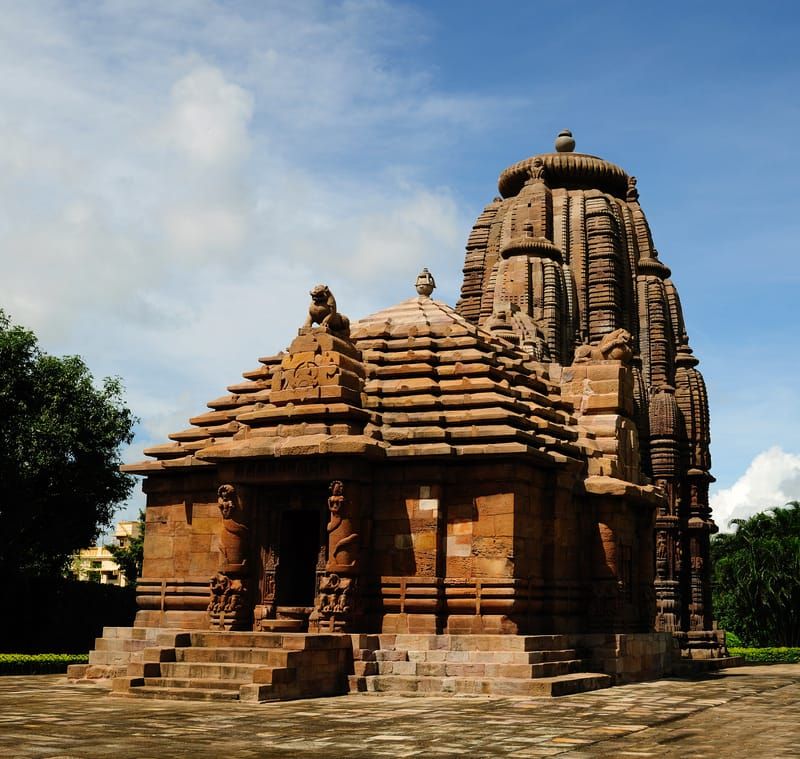
Rajarani Temple
This 11th-century temple derives its name from rajarani, a type of red sandstone used in its construction. The east facing shrine, which is bereft of any idols, displays the architectural magnificence of the old Kalinga sculptures.
It reveals multiple scroll work, and is somewhat different from other temples in the city and marks a different phase in the evolution of Oriya temple architecture. Its spire with multiple sub-spires bears semblance to the temples at Khajuraho. The temple’s most outstanding and best-preserved treasures are the standing astadikpalas on the central façade, standing on lotuses with their mounts below. The temple attracts visitors in droves during the Rajarani Music Festival which is part of the larger Ekamra Utsav held in December.
3.Siddheswar-MukteswarTemples
The twin temples of Siddheswar-Mukteswar within a single complex date back to the 10th century and stand as a significant transition point between the early and later phases of the Kalinga architectural style of temple building.
The 35-foot Mukteswar temple, built of sandstone, is considered one of the crowning glories of Oriyan architecture. The temples display an aesthetic blend of Hindu, Buddhist and Jain architecture, especially in their detailed carvings which narrate tales from the Panchatantra and carry animal figurines. The temple’s Jagmohan or porch is a masterpiece, bedecked with an eight-petalled lotus carved ceiling. The standing figure of Ganesha is majestic and arresting in the Siddheswar Temple, the sanctum of which is built in the pancha ratha style, surrounded by fivedivisional walls. The walls themselves are decorated with ornamental motifs and consist of seven moldings. Tiers of miniature turrets adorn the temple tower which holds aloft four lions, one on each corner.
4. Hirapur Chausath Yogini Temple
At the time when parts of ancient India were in the throes of the tantric cult, the central and eastern regions of the country witnessed the construction of numerous mystifying open air shrines. The Chausath Yogini Temple at Hirapur, which lies in close proximity to Bhubaneswar, is one of only four such surviving temples. The ninth-century hypaethral shrine, a circular-shaped edifice with no roof, is dedicated to 64 female spirits or ‘yoginis.’ Locally known as Mahamaya Mandir, the east-facing temple was discovered by Kedarnath Mahapatra of the Odisha State Museum in 1953. While the 10-armed Mahamaya Devi is the presiding deity, one of the most interesting and exceptional sculptures in the temple is that of Ekapada Shiva or one-legged Shiva.
5.Konark Sun Temple
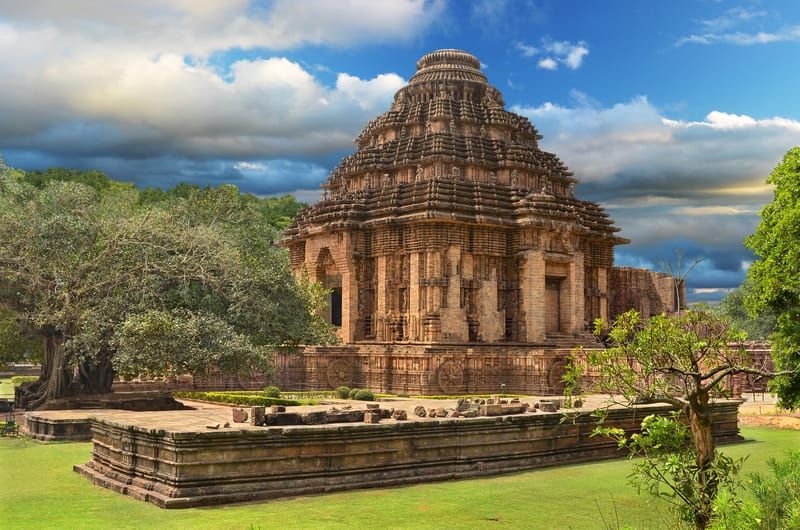
Konark Sun Temple
The Konark Sun Temple, a UNESCO World Heritage Site, was constructed in the 13th century by King Narasimhadeva. It was conceived as an ode to the Sun God in the form of a chariot. It stands on 24 intricately sculpted stone wheels of gargantuan proportions and is hauled by seven mighty horses. The edifice is embellished with a profusion of sculptures on its interior and exterior walls. Three surviving images of Surya are designed to capture the rays of the sun at dawn, noon and sunset. It took the labor of 1,200 artisans and 12 years to complete. Rabindranath Tagore wrote of Konark: “Here the language of stone surpasses the language of man.” During the annual Konark Dance Festival, held against the backdrop of the temple, Konark becomes a veritable smorgasbord of art and culture.
6. Puri Jagannath Temple
One of the Char Dhams or four sacred places of worship, the temple of Jagannath in Puri is built on a gigantic raised platform in the heart of the city. The temple complex is enclosed by a wall that is pierced by four gates with pyramidal structures over them. The east-facing Lions Gate leads to a vast open area, in the centre of which is the 11-metre-high monolithic pillar, known locally as the Aruna Stambha, with the figure of Aruna, the Sun God’s charioteer. This pillar was once in front of the Sun Temple at Konark. It was brought to Puri during the 18th century. Sprawled across 10.7 acres, the temple complex, built in the Kalinga style, is enclosed by two walls—the outer Meghanada Prachira, and the inner Kurma Bheda. The main sanctum is surrounded by 30 shrines of varying sizes. At the acme of the temple tower is the Nila Chakra or blue wheel, crafted from an alloy of eight metals, to which is attached the temple flag.
The temple of Jagannath is considered one of the tallest monuments in the Indian subcontinent and rises 214 feet from the ground. The construction of the monument was initiated by King Chora Ganga Deva and completed during the reign of his 12th-century descendant, Ananga Bhima Deva. The Rath Yatra in June-July is the temple’s flagship festival.
7.Barabati Fort
The once glorious nine-storeyed palace within the 14thcentury Barabati Fort in Cuttack on the bank of the Mahanadi is today a mound of ruins but for its gate, moat and a mosque. One can catch glimpses of the walls of the fort, built of sandstone and laterite. The gate still reveals some attractive carvings. The fort became an Archaeological Survey of the Indiaprotected site in 1915.
Deemed the culmination of the art and architecture of Odisha, it reveals a square plan, spread over 102 acres and surrounded by a paved moat of uniform dimensions. Flanking the mound of ruins in the center are the Shahi Mosque and Mazar of Hazrat Ali Bukhari. Purushottamdeva, the son of the Suryavanshi king, Kapilendradeva, brought an idol of Lord Krishna from Andhra Pradesh and installed it in a temple in the fort. However, only a portion of the temple remains.
Next to the fort ruins is the Barabati Stadium and close by is the Katak Chandi temple.
Buddhist circuit
Even though Lord Buddha never visited Odisha, the state was greatly influenced by his teachings. Buddhism was a leading religion in the state until the 15th century. There is a plethora of monasteries, stupas and Buddha idols, especially in the Diamond Triangle comprising Lalitgiri, Ratnagiri, Udayagiri, and Dhauligiri.
1.Dhauligiri
One of the most significant Buddhist sites in the world, Dhauligiri lies on the bank of the Daya river and is renowned for its third-century Asoka edicts, the Shanti Stupa or Peace Pagoda, and the nearby Buddhist monastery. It was here that Emperor Ashoka underwent a change of heart following the bloodbath of the Kalinga War.
2.Lalitgiri
The first-century Buddhist complex of Lalitgiri, also referred to as Naltigiri, has several rock-cut caves, viharas, chaityas, monasteries, stupas, and caskets of stone with Buddhist relics. A museum in its precincts contains caskets believed to enshrine the bones of the Buddha.
3. Ratnagiri
It has fairly well-preserved sculptures, large monasteries, shrines, big stupas, and a colossal statue of Lord Buddha. The museum here consists of four galleries with a long, stepped corridor displaying art objects and antiquities from the fifth to the 13th centuries. The finest relic of Buddhist art at Ratnagiri is a magnificent doorjamb adorning Monastery 1.
4.Udayagiri
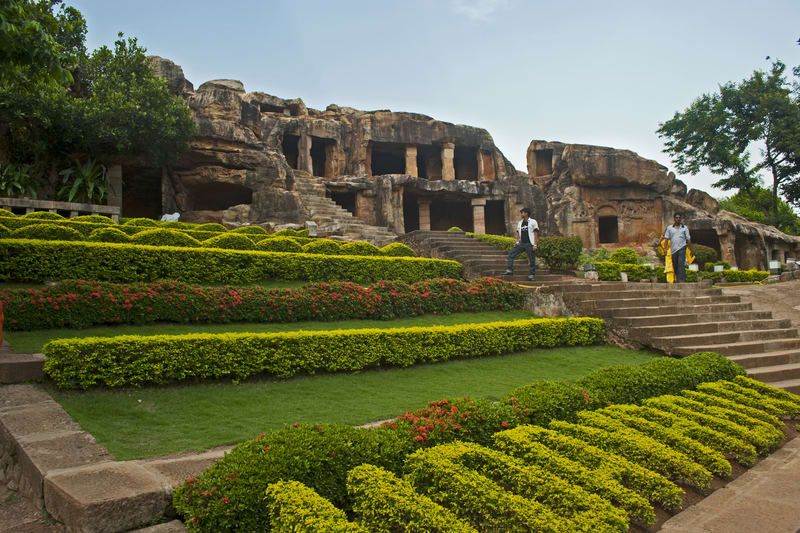
Udayagiri Rock Caves
This is the largest Buddhist site in Odisha. Pride of place is occupied by the stunning statue of the Avalokitesvara Buddha. Udayagiri is also home to rock-cut sculptures, a brick stupa, a couple of brick monasteries and a beautiful step well with inscriptions.
